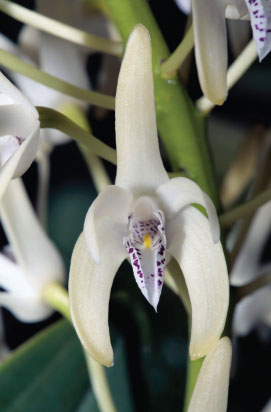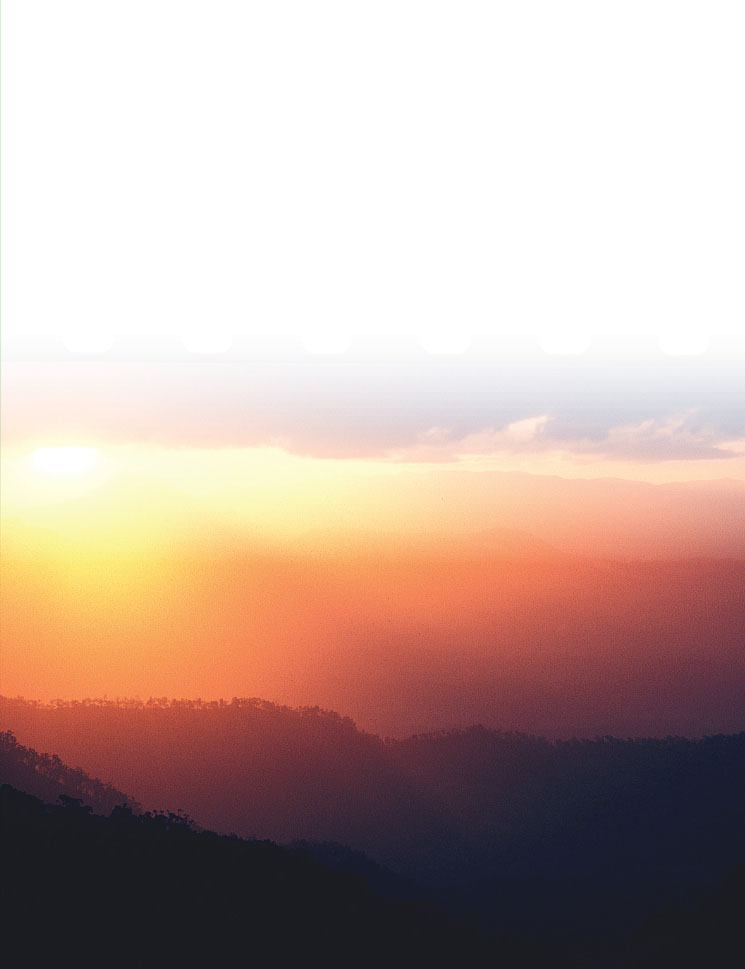
BOTANICAL NAME
Nothofagus moorei
DISTRIBUTION
South-eastern Queensland and north-eastern New South Wales, Australia, from the headwaters of the Manning River north to the McPherson Range.
OLDEST KNOWN LIVING SPECIMEN
Estimated at between 1,000–3,000 years old.
CONSERVATION STATUS
Not yet classified on the IUCN Red List of Threatened Species.

Ancient Antarctic beech trees growing on one of the high ridges of Lamington National Park in Queensland, Australia.
Looming through the cool mists that shroud remote, rainforest-covered mountain tops and ridges in eastern Australia, the majestic Antarctic beech (Nothofagus moorei), with its moss-covered trunks and branches, is one of Australia’s most venerable trees. With crooked, shaggy limbs that reach out like arms and fingers, a grove of ancient Antarctic beeches is an arresting sight, conjuring up the image of a secret world, a mythical landscape, lost in time. These beautiful trees, now rare outside the national parks in which they are protected, are found only in the south-eastern corner of Queensland, extending to the nearby North Coast and Northern Tablelands of north-eastern New South Wales.

The beautiful epiphytic beech orchid (Dendrobium falcorostrum) that uses the Antarctic beech as its host.
Maturing very slowly, the Antarctic beech gives the impression of being not one but several trees. Various trunks of different sizes are often joined together at their bases, in coppice formation, having grown up in a ring around what was once the parent trunk. Generally found leaning, and often gnarled with large burrs, they have a sculptural quality that implies great age.
Antarctic beeches do not appear to reach an enormous girth – about 3m (10ft) seems to be the maximum size for an individual trunk – but they may reach over 50m (164ft) in height, and are believed to be able to live for at least 3,000 years. Needing cool temperatures and constant moisture to thrive, the Antarctic beech grows naturally only above 600m (1,970ft), and up to 1,550m (5,080ft) above sea level. Here, in the cool temperate rainforest, where rainfall is high and mists are common, it has evolved as a dominant species among the other rainforest trees, preferring the banks of streams and deep gullies, as well as mountain ridges, as its habitat. Not surprisingly, a former common name for this impressive tree was ‘mountain beech’. The areas in which the Antarctic beech is found are characterized by a very low density of other tree species: sometimes only three may be present, but often only one.
Rising up from a forest floor that is largely carpeted with ferns of different kinds, the trunk and branches of the Antarctic beech are mostly concealed by the plethora of other plants that depend on them. Wiry vines, small ferns, mosses, lichens and orchids festoon their crooked trunks and branches. Referring to the Antarctic beeches he had seen growing in the region of the Dorrigo Mountain in New South Wales, the British-born Australian botanist J. H. Maiden (1859–1925) wrote in 1894, ‘No tree in the brush surpasses it in the quantity of epiphytal vegetation it supports.’

A time-worn Antarctic beech that has coppiced naturally to produce several large stems from a single trunk.
Beneath its mantle of mosses and other vegetation, the trunk of the Antarctic beech has a scaly, porous, dark red bark, though it turns dark brown when dead and is shed in large, irregular patches. Its twigs and small branches are covered with a brownish down. An evergreen, the tree has glossy, dark green leaves that are lance-shaped and finely toothed towards their tips. They feel rigid and leathery to the touch and are brittle in texture. The tree has a compact crown and is seldom without some red or orange-coloured dying leaves. New spring growth, however, is a deep red. It was this dramatic coloration that gave rise to an earlier name for the tree – red beech – and the name by which its timber has been traded, the Negrohead beech.

Antarctic beeches grow in subtropical Australia but are closely related to other southern beeches found in South America.
Nothofagus moorei is one of a number of related (Nothofagus) tree species, commonly referred to as southern beech, that are native to parts of the southern hemisphere. Here they have become important timber trees – in this respect being second only to the eucalyptus. Because of their similarity to the beeches of the northern hemisphere, botanists have traditionally described them as part of the tree family to which true beeches (the Fagaceae) belong. Recent research, however, has supported the view that they are in fact much more closely related to the birch family (the Betulaceae) and botanists now place them in a family of their own: the Nothofagaceae.
The Antarctic beech is a survivor from the remote past. Over 200 million years ago, the Antarctic continent was covered in luxuriant vegetation and formed part of the super-continent Gondwana. Fossil evidence from core samples taken from the ice below Antarctica shows that this vegetation included relatives of the Nothofagus species that survive in the southern hemisphere today.
Undoubtedly known to, and held in deep respect by, the Aborigine groups who once made use of the Australian forests in which these trees live, the Antarctic beech has taken its formal botanical name from the British botanist Charles Moore (1820–1905), who was appointed government botanist and director of the Botanic Gardens in Sydney by the Colonial Office in London in 1848.

The mountain ridges on the border of New South Wales and Queensland provide the last refuge for the most ancient Antarctic beeches.
He set about restoring the scientific character of the botanic gardens, which had become neglected, and, as an avid collector, travelled widely. Moore had a particular interest in the timber trees of Queensland and New South Wales, including the Antarctic beech. This tree had first been ‘discovered’ by a Mr Carron and a Mr W. A. B. Greaves, on the Upper Clarence River in New South Wales, in 1865. Moore named the Antarctic beech after Mr Carron, but it subsequently became one of the 19 species that were named after Moore himself (Fagus carronii C. Moore).

Antarctic beech trees grow in association with many types of epiphytes such as ferns, mosses and fungi.
An ancient partnership
Over thousands of years the rainforest has come to present a complex, delicate interaction between a vast array of living organisms. The majestic Antarctic beech has become the host for a variety of mosses, ferns and other epiphytic plants, but for one plant it has become almost its only home. This is the beautiful epiphytic orchid Dendrobium falcorostrum, one of the largest orchids to be found in the cool temperate rainforests of New South Wales. lt was once so common on Antarctic beeches that it was called the beech orchid, but now it is, like its host, rare in the wild.

Many of the trees are bent and gnarled. The very dark green foliage is striking, and the shape and habit of the leaves is handsome. Altogether, it is one of the most interesting of our forest trees.
J. H. MAIDEN, AGRICULTURAL GAZETTE, NEW SOUTH WALES, 1894

At the time that the Antarctic beech was first described (the end of the nineteenth century), the trees were much more numerous than they are today, forming dense forests on some of the high mountain slopes in New South Wales. Since it was a particularly slow-growing tree, however, the very hard timber that the Antarctic beech produced became highly sought after. In 1894, J. H. Maiden described the wood as follows:
‘It is the hardest timber of the brush, and it is also very heavy … There is no doubt that it is a most durable timber … I would look upon it as a valuable timber for culverts and such situations, where it is liable to wet, and I trust that the authorities will give it a fair trial … Large trees throw out burrs, from which depend aerial roots. The timbers of these burrs often yield a beautiful figure.’
The fine and even-textured timber – red when freshly cut, but drying to a pinkish colour – was thereafter extensively used for a number of purposes, including piano construction, cabinet work and soft turnery.
Because of past felling activity and because regeneration of the young seedlings is so slow, the magnificent Antarctic beech is now rare in the wild. The timber is still traded, however, and has a high commercial value. Fortunately, a number of magnificent examples of this ancient tree are now protected in a number of national parks and forest reserves across its natural range.